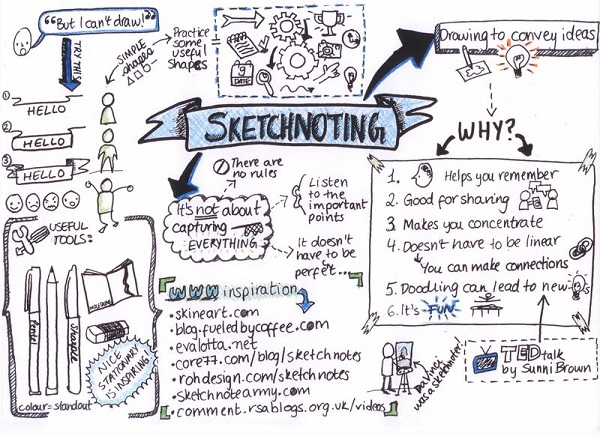ATD Blog
Trend Watch: Sketchnoting
Tue Apr 08 2014

Note-taking is never something anyone does for joy. Yet we do it to remember information and capture ideas—to facilitate learning. We’ve all sat in a classroom (or stood in front of it) and seen others frantically scribbling notes on the subject matter.
The problem with note-taking is that it doesn’t actually help us retain—or present—valuable information. We record pages and pages of notes, summarizing the subject matter, but not making much sense of it. (And as it turns out, typing notes is worse than hand-writing them. According to psychologist Herbert Wray, typing notes is so much faster that it actually encourages mindless transcription. In a study published in the journal Psychological Science, writers recorded less information but were better able to recall facts and conceptual ideas than typists.)
Notes are also a chore to slog through once the learning event is over. Reading them is a passive activity, like listening to a lecture—it’s not too stimulating.
So, how can we make note-taking fun and effective? Given what we know about how visuals help learners retain information (and the recent explosion of infographics), we might say that the solution has been staring us in the face.
Mike Rohde, an interface designer, illustrator, and author, created the concept of “sketchnotes” in 2007 while attending a conference. Frustrated with his attempts to record information through longhand note-taking, Rohde began peppering his notes with simple drawings and typography. He found that these visual notes helped him retain more information, and think more deeply and critically about it. Plus, sketchnoting was fun.
Rohde’s sketchnotes began garnering attention on the web. Before long, major conferences (like SXSW and the World Domination Summit) hired him to capture sketchnotes on keynote speeches and other presentations. In 2012, Rohde came out with The Sketchnote Handbook, a book and video that shows “regular people” (non-designers and non-artists) how to create sketchnotes that aid learning and retention. The handbook breaks down sketchnoting into clear, simple steps that anyone can follow regardless of his artistic ability.
As Rohde points out, “You needn’t be a Leonardo to draw your way to more and better ideas…think of sketching as visual thinking. Ugly gets the job done just fine.” In his handbook, Rohde shows readers how sketches are made up of five basic shapes. Once you get the hang of those simple sketches, and how to incorporate them into your regular notes, you’re ready to use sketchnoting for a variety of purposes: brainstorming sessions, idea mapping, project planning, process improvement, and so forth.
Why should those working with learning technlogies be interested in this trend? Sketchnoting is also a handy tool for prototyping e-learning interfaces.
For more information on sketchnoting, check out Mike Rohde’s blog and this video, or get inspiration from an online community of sketchnoters.
You've Reached ATD Member-only Content
Become an ATD member to continue
Already a member?Sign In
